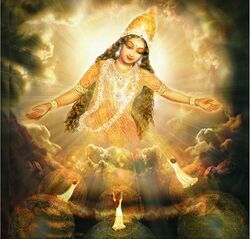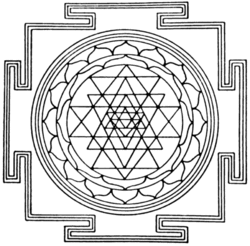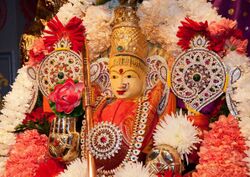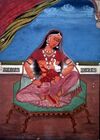Religion:Adi Parashakti
| Adi Parashakti | |
|---|---|
The Mother Goddess, Mahadevi; The Cosmic Energy and The Divine Power; Supreme Being, Para Brahman (Shaktism) | |
 Adi Parashakti as the supreme goddess | |
| Affiliation | Para Brahman,(Shaktism), Shakti, Parvati, Lakshmi, Saraswati, Durga, Kali, Radha, Tripura Sundari [1] |
| Abode | Manidvipa |
| Mantra | Om aim hreem shreem kleem[2] |
| Weapon | Pasha, Ankusha, Chakra, Shankh, Trishula and Rosary |
| Texts | Devi Mahatmya, Devi-Bhagavata Purana, Kalika Purana, Lalita sahasranama, Shakta Upanishads such as the Devi Upanishad[3] |
Adi Parashakti (Sanskrit: आदि पराशक्ति, IAST: Ādi Parāśakti) is term which means primordial energy or primordial force, denoting the Supreme Goddess or Divine Mother in Hinduism.[4] The goddess is also popularly referred to as "Parama Shakti", "Adi Shakti", "Mahashakti", "Mahadevi", "Aadhya Shakti", Satyam Shakti, or even simply as "Shakti". Shaktas believe Adi Parashakti as the Supreme Being, manifested as the triple goddesses Saraswati, Lakshmi and Parvati. The Shakta-Shaivism consider Parvati as her primary form, while the Vaishnavism traditions consider it to be Lakshmi or Radha.[5]
Etymology
Adi Parashakti means "First Supreme-energy". आदि ādi literally means "beginning". Shakti refers to a power beyond the physical universe; the term itself comes from the root शक् śak, meaning "to be able".[6]
Hinduism
Except for Shakta Puranas, Adi Shakti has never been mentioned with the name "Adi Shakti". Scriptures like Devi Bhagavata Purana, four Vedas talks of Dark energy which dissolves the complete universe along with time. Many scholars compare the concept of Adi shakti to the modern discoveries of Dark Energy, Vacuum Energy and Zero Energy in the field of Science and technology.[7]
Shaivism
Shiva Purana says Adi Parashakti incarnated in materialistic form as Parama Prakriti from the left half of Lord Shiva i.e.Parabrahman Paramshiva during the beginning of the Universe. Linga Purana states that Adi Shakti brings forth the evolution of life in every Universe through the union of every Parvati and Shiva in all of the Universes. Skanda Purana and Markandeya Purana talks about Parvati as divine mother of all creation and truest material form of Adi Shakti.[8]
Shaktism
Importance
In the Devi Gita, it is suggested that before incarnating as Parvathi, she appeared to King Himalaya and revealed divine, eternal knowledge to him. She explained herself, in the words of the Vedas, as having neither beginning nor end. She is the only, eternal truth. The whole universe is her creation. She is the only victor and the manifestation of victory itself. She is a manifested, un-manifested and transcendent divinity. She then displayed her scarcely seen form to him: Satyaloka was located in her forehead; the created universe were her hairs; the sun and moon were her eyes; in her ears were the four directions; the Vedas were her words; death, affection and emotion were her teeth; maya was manifested by her smile.[9][non-primary source needed] The goddess Parvati as Kushmanda gives birth to the universe in the form of an cosmic egg which manifests as the universe. Ultimately, Adi Shakti herself is the zero energy which exists even after destruction of the universe and before its creation.[citation needed]
Shakta Puranas
The Devi Bhagavata Purana says that Shiva worshipped and meditated on Adi Parashakti for thousands of years, using the beeja mantra "Hreem". She then manifested one of her Shaktis in front of him in the form of Sidhidaatri from the left half of Lord Shiva . The Goddess Adi Parashakti is also considered to be both the truly supreme spirit without form (Param Atman) and Saguna with form. In her Saguna form she is described as the Mother of the Universe and is residing in Sarvaloka Manidweepa above all of the other Paralokas. She is the Great Goddess, and all other goddesses and even all the Gods are her various forms, says the Devi Gita from Shakti Mahabhagawata Purana.[10][unreliable source?] In Devi Mahatmyam, Trimurti and demigods praises Adi Shakti:
Shrishti Sthiti Vinasham Shakti Bhute Sanatane
Guna Shaye (Devoid of all attributes i.e. Nirgun) Gana maye (Having all the attributes) Narayani Namaustute[11]
This translates to:
We bow to the first female (Narayani), The eternal energy who creates, sustains and destroys all the elements i.e. tatva and the one who is truly the supreme spirit (Nirgun) at the time who encapsulates all the attributes for Generation, Observation and Destruction.
Role in creation
In Srimad Devi Bhagwat Purana's 1st book and 4th chapter. Devi addressed Trimurti as follows: "I am Adi Parashakti. I am the owner of this universe. I am the Absolute Reality. I am dynamic in feminine form and static in masculine form. You have appeared to govern the universe through my energy. You are the masculine form of Absolute Reality, while I am the feminine form of that Reality. I am beyond form, beyond everything, and all the powers of God are contained within me. You must know that I am the Eternal limitless energy."[12]
She then said: Brahma! You will be the generator of the universe; the Goddess Sharada (Saraswati) is your consort, she will be recognized as the goddess of wisdom and the primeval sound. Lord Brahma, this goddess will be with you when you create the universe.
She continued: Lord Narayana (Vishnu)! You are formless, yet you take form. I assign you to be the preserver of the universe. You will take a different incarnation in order to save this universe's inhabitants. Oh, Narayana! You have created Lord Brahma, and Brahma will further create thirty-three kinds of gods and goddesses. I am goddess Mahamaya, I reappear from your mystic sleep. Your consort will be goddess Lakshmi. Lord Vishnu, this goddess will be with you when you rule/maintain the universe. When life evolves, you will take the form of Vishnu, the one who will perform the task of observing and preserving this universe.
At Last, she instructed: Oh Lord Rudra Shiva, the Great God, you are the personification of time, which is above all. You will perform the task of destroying and regenerating this universe. When you are formless, time stands still. It is due to my power that you become dynamic and are capable of bringing about the destruction and regeneration of this universe. Mahakali is myself, my full form, and due to meditation, you will surpass all my forms. It is then that I will incarnate from your left half in my manifested form. This form will be my truest manifested form. Lord Shiva, she will perform the task of destroying evil and will be your consort. [13]
Adi Parashakti's Forms
Devi Parvati is the full and complete physical incarnation of the goddess.[16] Parvati was Sati in her previous birth. Sati was also a direct incarnation of Adi Parashakti. However, Sati died and was reborn as Parvati. Parvati is shown as kind and loving mother goddess. She can take various forms including Kali, Durga, Chandi, etc.
According to Shakta traditions, Lalita tripurasundari is the ultimate god. Lalita Tripurasundari holds a sugarcane bow, flower arrows, noose, and goad. She came down from Manidweepa above this Brahmanda to destroy Bhandasura. Her abode is pictorially represented as Sri Chakra. Brahma, Vishnu, Shiva of this Brahmanda are her subordinates and cannot function without her power. Thus, she is considered the supreme Goddess and primary deity in Shaktism as she is the nearest representative of Adi Parashakti. Whatever deity one is worshiping, ultimately, they are worshiping Adi Parashakti.[citation needed]
She took various incarnations over a period of time for upholding Dharma. As per the yogis of the highest order, she is the power who resides in the Kundalini in the form of Amba, she is 31/2 coil in size and when the Kundalini is raised from the sacrum bone of every human being by a highly realized soul whose kundalini is also awakened then she rises through the back bone of the human opening all chakras mooladhara, Swadisthana, manipura, anahata, vishuddi, Agnya and finally through sahasrara chakras and connects the soul to the all pervading power (or collective consciousness) of the divine.[citation needed]
On the three nadis, Ida (Left channel- Tamo guna), Pingala (Right channel-Rajo Guna) and Sushumna (central channel-Sattva guna), the kundalini passes through the central channel balancing all the left and right channel.[citation needed]
Kali is the third part of Goddess Adi Para Shakti. She is the goddess of power, spiritual fulfillment, time, as well as presiding over the destruction of the universe. She gives salvation to mankind. Shaktas consider her as the incarnation of Parvati and consort of Shiva's incarnation Mahakala. She helped Lord Maha Vishnu slay the demons Madhu and Kaitabha. It is she who also slew Shumbha and Nishumbha in the form of Kaushiki, who are symbols of ignorance. She is also same as Yogmaya also known as Tamsi Devi and Chandi Devi as per Durga Saptashati. She wears red or black and presides over the Tamas Guna. When Kali is formless, she becomes the sound of Kreem. In her gentler form as Durga, she becomes the sound of Kleem.[citation needed]
Worship

Shaktas claim that it is assumed that indirectly or directly, everybody worships her. When, someone is utilizing his/her energy in positive aspects of life then they are worshiping her. Hypothetically Shaktas assume, since, she is absolute Energy, so when one knows how to raise his/her inner energy and knows how to balance that energy for daily work then ultimately, they are worshiping her. To balance Energy for day-to-day life, people worship their personal gods/God as per their religion, enlighten candles and lamps at home, do good work for society and much more. All these activities either energize them or serve as methods to gain motivation.[citation needed]
Many scholars like Swami Vivekananda prefers meditation as best practice to stop mental impurities as he said Holy meditation helps to burn out all mental impurities and claims that to know one's own energy is best method to worship Divine Mother.[citation needed]
Though core shakta people believe in direct worship of Adi Shakti through dhyan, Meditation and Samadhi, Tantra, Sri chakra and traditional deity worship. While worshiping her through yoga, Samadhi or through Tantra, one needs proper adherent guru, who himself or herself must know all the rules and rituals.[17][unreliable source?] If someone who doesn't have proper guru, then one can also worship her by singing her praise.[citation needed]
Iconography
Adi Parashakti is generally seen as an abstract goddess but her appearances is described in the Devi Bhagavata Purana, Kalika Purana, Markandeya Purana-Devi Mahatmya, Brahmanda Purana-Lalita Sahasranama, and the Tripura Rahasya. According to the Devi Bhagavata Purana, the goddess once invited the Trimurti to Manidvipa. The Trimurti saw the supreme goddess sitting on a jeweled seat in a throne. Her face contained the radiance of millions of stars and her celestial beauty was so great that the Trimurti were not able to look at her. She carries the surya mudra, pasha, ankusha and lotus. They then realized that she was the energy responsible for creating, preserving, and destroying the whole universe.[18]
Adi Parashakti in Sikhism
Sikhism also portrays the concept of Adi Shakti. The difference is in the philosophy. In Sikhism, Khanda, the symbol of the infinite power of God, is referred as "Adi Shakti" in Hinduism.[19] Durga, one of the Shaktis of Adi Shakti as per Hinduism, are manifestations of Adi Shakti to destroy demons as described in Chandi di Var.
Association with other deities
Adi Shakti is regarded as the one who can control all the nine planets. She divides herself to Material Shakti i.e. Durga who splits herself to operate nine planets to maintain cosmic order, Vidya Shakti i.e. Kali as source for 10 incarnations of Lord Vishnu and Maya Shakti, to delude the beings to illusion and also promotes the beings to Ultimate God.[citation needed]
As Durga She is the one who splits herself to Navadurgas provides direction and energy to all planets.[citation needed]
- Surya (Sun) is Governed by Kushmanda.
- Mahagauri operates Rahu (Ascending lunar node).
- Kaalratri governs Shani (Saturn).
- Ketu (Descending lunar node) is governed by Goddess Siddhidatri.
- Provider of Knowledge i.e. Brihaspati (Jupiter) is governed by Goddess Katyayini
- Provider of All Fortunes i.e. Mangala (Mars) is governed by Goddess Brahmacharini
- The effect of Chandra (Moon) is overcome by Goddess Shailaputri
- Budha (Mercury) Planet is governed by Goddess Skandamata
- Shukra (Venus) Planet is operated by Goddess Chandraghanta
By this contrast Goddess Adi Shakti controls the Navagrahas. Worshipping the nine goddess in Navaratri or Nine nights of Durga, saves you from the dangerous effects of the planets.
Association with Beings (demi-gods, living beings and demons)
- Yoga Maya
Adi Parashakti is the one who actually creates maya for gods and teaches them what to do and what not to do so that they can be connected to the ultimate God. She helped Lord Vishnu to slay the demons Madhu and Kaitabha to save the world. Moreover, she is also the one that who takes Lord Vishnu to mystic sleep hence called Yog Nindra of Lord Narayana. It is required by yogis, sages and bhaktas so that they can be connected to God. Shaivas consider her as the form of goddess Parvati, while Vaishnavas consider her as godess Lakshmi.
- Mahamaya
She is the goddess that destroys the upfold of illusion. She is the one that creates and destroys maya. She is controlled by Yogmaya and hence subordinate to YogMaya and senior to Maya. She emerges as seven mothers to destroy evil forces of Shumbha and Nishumbha, Being Chamunda one of them. She is required to gain physical strength, health, satvik attributes and demotes anger, greed and arrogance. Vaishnavas consider her as Lakshmi while the Shaivas consider her as form of Parvati[20]
- Maya
She is the one who delude living beings from god and takes any being to the world of illusion. She promotes greed, anger, and arrogance. It is assumed that in the Age of Kali Yuga, her effect is highest.[21]
See also
- Shakti
- Parashakti
- Shaktism
- Devi
Notes
- ↑ Sitaramiah, Pavani (1993). Sri Kalahasti Easwara Mahima. Pavani Sitaramiah. p. 90. https://books.google.com/books?id=fn_XAAAAMAAJ.
- ↑ Swami Narayanananda (1960). The Primal Power in Man: The Kundalini Shakti. Health Research Books. p. 50. ISBN 9780787306311. https://books.google.com/books?id=6_sKqkhwRzoC.
- ↑ Jones, Constance; Ryan, James (2014). Encyclopedia of Hinduism. Infobase Publishing. p. 399. ISBN 978-0816054589. https://books.google.com/books?id=hZET2sSUVsgC.
- ↑ "Adi Para Shakti- Divine mother" (in en-US). 2017-12-13. https://www.hinduscriptures.com/gods/goddesses/adi-para-shakti-divine-mother/1392/.
- ↑ Vanamali (21 July 2008). Shakti: Realm of the Divine Mother. Simon and Schuster. p. 204. ISBN 9781594777851. https://books.google.com/books?id=3FwoDwAAQBAJ&pg=PT204. "The sages declared that the waters were contained in the womb of the primeval Divine Mother, Adi Lakshmi or Adi Shakti. Adi means “first,” implying that she existed before everything else."
- ↑ SARASWATI, SARANYU S. (2020-10-05) (in en). Biological Decoding of the Hindu Gods and Goddesses. Notion Press. ISBN 978-1-64951-634-3. https://books.google.com/books?id=SAoBEAAAQBAJ&q=adi+parashakti+meaning&pg=PT82.
- ↑ Prof. Shrikant Prasoon. The Creator Of Universe Ma Shakti. HINDOOLOGY BOOKS. ISBN 978-8-122-31100-6. http://www.pustakmahal.com/books/book.php/creator-universe-ma-shakti-prof-shrikant-prasoon/isbn-9788122311006/zb,,44e,a,1d,USD,32,a/index.html. Retrieved 5 January 2021.
- ↑ Shiva Mahapurana | Gitapress Gorakhpur
- ↑ "The Devi Gita index". Sacred-texts.com. http://www.sacred-texts.com/hin/dg/.
- ↑ Sri Bhagwati Gita | Devi Gita | Sri Parvati Gita – Scribd | https://www.scribd.com/doc/147548723/Sri-Bhagwati-Gita-Devi-Gita-Sri-Parvati-Gita
- ↑ Matri – Dhyan – Anandamayi Ma | anandamayi.org/chant/chant.htm
- ↑ https://www.wisdomlib.org/hinduism/book/devi-bhagavata-purana/d/doc57103.html
- ↑ "Hindu Purana - Creation of Universe - Daily News Watch – An Effort to Unite India". DailyNewsWatch. February 26, 2014. http://dailynewswatch.in/hindu-purana-creation-of-universe/.
- ↑ Vasantānanta (Swami.), Nā Irāmaccantiraṉ (1993). Sri Lalita Sahasranamam: Nama-wise Commentary in English with Text in Sanskrit. p. 358. https://books.google.com/books?id=6OItAAAAYAAJ.
- ↑ Śaṅkarācārya; Tapasyananda (Swami.); Lakṣmīdhara (1987). Saundarya-lahari of Sri Sankaracarya: with text and translation, and notes based on Lakṣmīdhara's commentary. Sri Ramakrishna Math. p. 70. https://books.google.com/books?id=V4rXAAAAMAAJ.
- ↑ Kinsley, David (1998) (in en). Hindu Goddesses: Visions of the Divine Feminine in the Hindu Religious Tradition. Motilal Banarsidass Publ.. ISBN 978-81-208-0394-7. https://books.google.com/books?id=hgTOZEyrVtIC.
- ↑ "Shakti Worship and Sri Ramakrishna". Swami Prabhananda. http://www.eng.vedanta.ru/library/prabuddha_bharata/shakti_worship_and_sri_ramakrishna_nov2004.php.
- ↑ Kinsley, David (1998) (in en). Hindu Goddesses: Visions of the Divine Feminine in the Hindu Religious Tradition. Motilal Banarsidass Publ.. ISBN 978-81-208-0394-7. https://books.google.com/books?id=hgTOZEyrVtIC.
- ↑ "Divine Mother". http://hindumythologybynarin.blogspot.in/2013/05/the-divine-mother-adi-parashakti.html.
- ↑ The Heart of Hinduism: The Eastern Path to Freedom, Empowerment and Illumination. Stephen Knapp. 2005. ISBN 9780595350759. https://books.google.com/books?id=a2KPChj7lTwC&q=yogmaya+vs+mahamaya&pg=PA127. Retrieved 10 December 2014.
- ↑ Srimad Bhagwata Purana
References
- Brown, Cheever Mackenzie (1998). The Devī Gītā: the song of the Goddess; a translation, annotation, and commentary.
- Kinsley, David. Hindu Goddesses: Vision of the Divine Feminine in the Hindu Religious Traditions. ISBN:81-208-0379-5.





